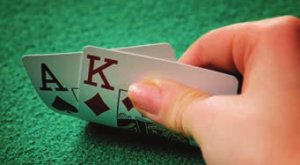Whether you’re an experienced poker player or still learning the intricacies of the game, one thing we know for sure is that your day will be much more difficult if you have an aggressive player to your left. WGM explains how to deal with someone who keeps re-raising.
In our April 2018 issue of WGM, we took an in-depth look at the art of 3-betting in poker – when to do it, why to do it and what traits you should be looking for in each opponent in order to determine an appropriate 3-betting range.
3-betting, particularly in position, is not only an extremely important skill to hone at the poker table in order to maximize your profits, it’s also one of the most effective tools you can use to force mistakes from your opponents … not to mention the somewhat sadistic pleasure to be gained from watching them go mad with frustration!
But what about when the shoe is on the other foot? As satisfying as it can be to constantly force folds from your opponents through well-timed aggression, it’s not quite as much fun when you’re the one being 3-bet time and time again.
But just as implementing a well thought-out plan when 3-betting will make you much more difficult to play against, there are a number of key adjustments you can make when facing a 3-bet to take advantage of an opponent’s aggression. Get it right and you might even stop them raising you!

Let’s start with the basics. Invariably if you are opening the pot pre-flop then being forced to fold when the button 3-bets, the hands you are choosing to play aren’t strong enough to continue with so it makes sense that step one is to narrow your opening range. For example, against certain players you might always raise with a hand like A7 suited in the cut-off but if you’re facing a player who loves to 3-bet on the button it might be wise to fold that A7 rather than throw dead money into the pot. Too many inexperienced players set themselves a default range of hands they will raise with in certain positions when they should instead be adjusting those ranges based on the tendencies of the players to their left.
By cutting these marginal hands out of our opening range against an aggressive 3-bettor we are therefore strengthening the range of hands we do choose to play and eliminating opportunities to be pushed around.
“But wait,” I hear you say. “If our opponent’s aggression has forced us to change our game and start folding hands we would normally open, hasn’t our opponent won the war?”
The short answer is no. While the natural instinct of some players facing regular 3-bets is to start 4-betting with these marginal hands, your opponent has already demonstrated that they are both aggressive and able to apply pressure so although 4-betting as a bluff might work occasionally, it won’t take long for them to figure out what you’re doing and start shoving over the top.
Which leads us to stage two of our plan – and this is the fun bit. Although we have now reduced the range of hands we are opening with, we are actually going to increase our value range against this opponent and by doing so turn the heat straight back onto them.
Exactly what this range will look like depends upon a few factors including just how aggressive your opponent is and the history between the two of you but a decent example might be pocket pairs from 8s upwards and AQ or better. In some cases you might be able to expand that range even further, perhaps taking in all pocket pairs down to 2s, AJ and even KQ suited. The key concept here is that you have adjusted your range so that it is on average stronger than your opponent’s range.

Once you have calculated an appropriate range, you will then muck all other hands pre-flop when your opponent has position on you.
When you do eventually look down to see one of the hands in your value range staring back at you, it’s time to put the foot down by opening the pot and 4-betting over the top of his 3-bet with the intention of calling if he shoves. You will not be folding here.
Of course, there will always be annoying hurdles to overcome when you implement a plan such as this – don’t forget that even maniacs are dealt Aces just as often as you are – but in the long run you will enjoy far more gain than pain.
There is also one small adjustment you can make to this plan to take further advantage of the chronic 3-bettor’s aggressive tendencies when you are lucky enough to be dealt AA. Rather than 4-bet with this strongest of all starting hands you can call instead and then check-raise and get it in on just about any flop. This play can also be used with KK provided you slow down if an A lands on the flop, although it’s important you don’t fall into the trap of always calling with these monster hands while 4-betting the rest of your value range. Mix it up and keep your opponents guessing!

Either way, the benefit of implementing a plan such as this is that it enables you to nullify your positional disadvantage.
So, what to do then when you are opening on the button only to have your opponent start 3-betting you out of the blinds?
For starters, this is a far more appealing scenario because we have position and therefore more options in how we can play certain hands – or in many cases whether we can play some hands at all! Take a hand like AJ suited for example. It’s a strong hand – among the top 7 percent or so of starting hands you can be dealt – but faced with a late position 3-bet it suddenly becomes a very tricky proposition. Should you have this same hand on the button when facing a 3-bet from the blinds, however, you can comfortably call against most players, most of the time.
Unlike playing out of position where we have recommended adopting a strategy of opening the pot only with the range of hands you plan to get it in with if raised, our button range can be broken down into as many as four different categories. The first of these is hands we’ll fold pre-flop and it’s important to note that even with position we should be opening a much smaller range of hands than we would against a player who usually folds or calls. Second are our value hands at the top end of the spectrum. Again, just like playing out of position, these are the ones we will 4-bet with and call a shove such as big pairs and AK.
Category three includes hands we can occasionally 4-bet with but fold if our opponent shoves. These are hands that aren’t good enough to call a 3-bet but have blockers to the hands your opponent is representing, so some good examples might be A4 suited or K9 suited. The theory here is that because you hold one of the four Aces in the deck, for example, it is mathematically less likely your opponent has one which therefore reduces the range of big hands they can have.

Also, even though we’re folding to a shove, being in position means we will rarely have to worry about our opponent calling and putting us to the test (if your opponent does flat your 4-bet out of position it’s a fair bet they’ve got AA or KK).
The final category is hands we plan to call a 3-bet with. Your range here should mostly include hands that figure to be ahead of your opponent’s 3-betting range but aren’t strong enough to call a shove if you had chosen to 4-bet instead, plus hands that can flop well such as medium pairs, suited connectors and a lot of suited Broadway cards. Any time you flop a decent draw in this scenario you should be raising and looking to get it in.
The button is also a great place from which to call a 3-bet with Aces which allows you to balance your range while disguising the strength of your hand!
There isn’t a poker player on the planet who hasn’t been troubled by an opponent’s relentless 3-betting but hopefully we’ve been able to show you that rather than letting frustration grow, there are clear strategies you can employ to not only stay out of trouble but use those 3-bets to your advantage. Just keep in mind that this is a longterm strategy so don’t be discouraged when you make a play based on your assigned ranges only to find that your opponent actually has the AA he was representing. From time to time it’s going to happen.
It’s also important to note that these strategies aren’t the one and only way to go. Among others, we haven’t even touched on situations where you can call 3-bets out of position, but let’s leave that discussion for another day. As long as you implement a well-reasoned plan and have the patience and courage to follow through, your game will go to another level.







